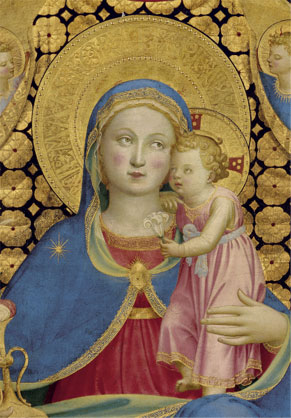
Fra Angelico
The Madonna of Humility, c. 1433-1435 (detail)
Colección Thyssen-Bornemisza,
on deposit with Museu Nacional
d'Art de Catalunya (MNAC)
The Madonna of Humility, c. 1433-1435 (detail)
Colección Thyssen-Bornemisza,
on deposit with Museu Nacional
d'Art de Catalunya (MNAC)


7 March to 14 May 2006
free entrance
free entrance

| The exhibition Contexts of the Permanent Collection 18 is devoted to the Italian painter Fra Angelico and his panel painting The Madonna of Humility. Along with 63 other works, this masterpiece is part of the group of paintings on long-term loan from the Thyssen-Bornemisza Museum to the Museu Nacional d'Art de Catalunya in Barcelona. In addition to The Madonna of Humility, the exhibition also provides the opportunity to see twelve further panel paintings normally on display in the Museum's galleries or in Barcelona. |
| Fra Angelico was born near Vicchio (Tuscany) around 1395-1400 and began his artistic career as a miniaturist. Before he entered the Dominican Order his name was Guido di Piero. His first endeavours as a painter would seem to date from around the second half of 1410, and by the middle of the following decade he had begun to acquire a reputation in artistic circles. Guido di Piero entered the Dominican Order, taking the name of Fra Giovanni, at some point between 1418 and 1421 and he is mentioned for the first time as a friar at San Domenico in Fiesole in 1423. Among his early works is the altarpiece of The Virgin and Child enthroned with Saints Thomas of Aquinus, Barnabus, Dominic and Peter Martyr, painted for his monastery. His first documented work, however, is the Linaiuoli Madonna (Museo di San Marco, Florence), commissioned on 11 July 1433 and marking the start of his mature period. In 1436 the Dominican Order was entrusted with the monastery of San Marco in Florence, and the artist is documented there in August 1441. In addition to producing altarpieces and smaller devotional panels, Fra Angelico also decorated the monks' cells and other rooms in the monastery with a series of frescoes. These depicted episodes of Christian doctrine in a clear and pleasing manner with the intention of both instructing his fellow monks and inspiring them to devotion. Between 1447 and 1450 he was active in the Vatican in Rome where he executed a cycle of Scenes from the Lives of Saints Stephen and Lawrence for one of its chapel. After a period in Fiesole, he returned to Rome where he died on 18 February 1455. |
| In addition to Fra Angelico's The Madonna of Humility, the exhibition includes a further twelve Italian panel paintings of the Trecento and Quattrocento by leading artists from the most important artistic centres. Using these images, the exhibition analyses two iconographic types of Marian images which were particularly influential in the history of art: the Virgin of Humility and the Virgin and Child enthroned. In addition, it looks at the subject of the Coronation of the Virgin, the episode that closes the cycle of the Glorification of Mary. |
| The Virgin of Humility is the subject of both Fra Angelico's panel (cat. 1), as well as others by an anonymous Venetian painter of around 1360 (cat. 10), by Cenni di Francesco di ser Cenni (cat. 11), and by the Sienese artist Giovanni di Paolo (cat. 13). The Virgin of Humility was a devotional subject in which the key figures take on a greater human quality than in previous iconographic types. It arose in the late 13th century, spreading across Italy during the next century and becoming particularly popular in cities such as Siena. From Italy it spread to other countries including Spain, where it was widely accepted, particularly in Catalunya. In such works the Virgin is depicted as seated on a cushion on the ground, and in some versions breast-feeds the Infant Christ (cats. 10 and 11). With its tender, intimate mood, the subject was disseminated and promoted by the preaching orders such as the Dominicans, to which Fra Angelico belonged, as well as the Augustinians and Franciscans. |
| Close precedents for the model of the Virgin of Humility are the Nativity and Adoration scenes in which Mary is seated on a sort of mat, holding the Christ Child or watching over him. This is the case with the panels by Pietro da Rimini (cat. 3), Taddeo Gaddi (cat. 5) and Luca di Tommè (cat. 9). |
| The Virgin and Child enthroned was the other iconographic model that was transformed in Italy during the Trecento and popularised with the name of Maestà. In such works Mary is depicted as solemnly enthroned as the Mother of God, in a presentation that fully expresses her majesty and grandeur. In some versions she is accompanied by angels, saints, apostles, donors or the blessed, who pay homage to her in their role as intercessors. Paintings of this type include the panels by the Master of the Magdalen (cat. 2), Bartolomeo di Messer Bulgarino (cat. 7), Niccolò di Tommaso (cat. 8), and the delicate work by Lorenzo Monaco (cat. 12). |
| The exhibition concludes with two works: A Virgin and Child by Bernardo Daddi (cat. 4), and a Coronation by the Master of 1355 (cat. 6). The latter conforms to an iconographic type disseminated during the 13th and 14th centuries in which Christ crowns his mother as Queen of Heaven in the presence of musical angels. |
